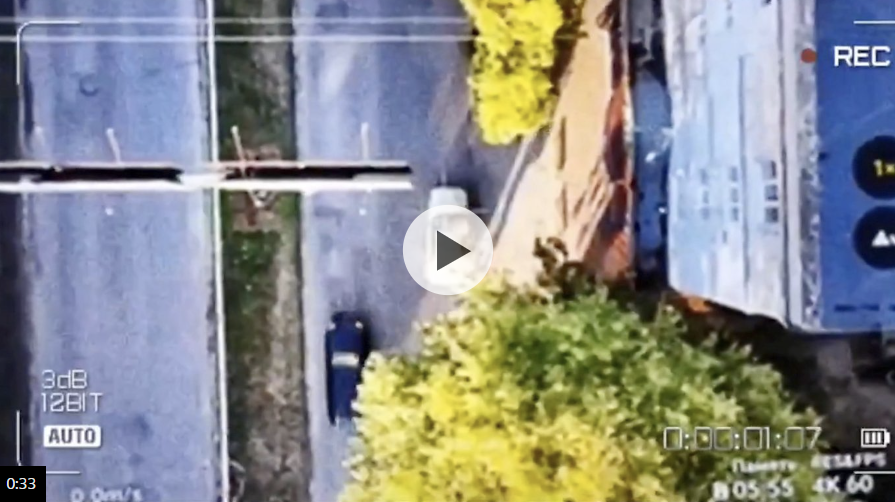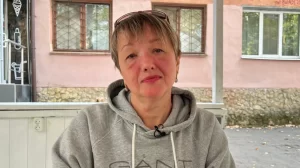Russian drones hunt civilians, evidence suggests
4 min read
Drone strikes in Kherson

Drone strikes in Kherson
In southern Ukraine’s Kherson, a tragic event unfolded when Serhiy Dobrovolsky, a hardware trader, returned home one day. Shortly after arriving, he stepped into his yard to enjoy a moment of respite. However, the peaceful atmosphere shattered when a drone buzzed overhead, followed by the sudden drop of a grenade. His wife, Angela, recalls the horrifying moment: “He died before the ambulance arrived. I was told he was very unlucky, because a piece of shrapnel pierced his heart.”
Serhiy was one of 30 civilians killed during a disturbing surge of Russian drone attacks in Kherson since July 1, according to the city’s military administration. Over this period, more than 5,000 drone strikes have been reported, resulting in over 400 civilian injuries. While drones have transformed warfare dynamics in Ukraine—employed by both Ukraine and Russia for military purposes—eyewitness accounts and credible evidence suggest a troubling trend: Russian forces are targeting civilians in this frontline city.
Angela expressed her outrage, stating, “They can see who they are killing. Is this how they want to fight, by just bombing people walking in the streets?” If intentional civilian targeting is confirmed, it would constitute a war crime under international law. Despite these serious allegations, the Russian military has not responded to inquiries from the BBC regarding these claims. Russia has consistently denied any deliberate attacks on civilians since its full-scale invasion of Ukraine in February 2022.
The evidence of drone strikes on civilians is supported by numerous videos circulating on social media platforms. The BBC Verify team analyzed six videos showing drone operators tracking pedestrians or motorists, subsequently dropping grenades that seriously injured or killed their targets. A Telegram channel was identified as the first public source of five of these six videos, with posts that taunted the Ukrainian public, declaring all vehicles fair game and advising people to minimize their public presence. Those injured were derided with derogatory terms, including “pigs.”

In Kherson, the military administration reported a shift in the types of drones being used, rendering local electronic systems unable to intercept many of them. “You feel like you’re constantly being hunted, like someone is always looking at you, and can drop explosives at any moment. It’s the worst thing,” says Kristina Synia, who works at an aid center near the Dnipro River. To navigate safely, she and her colleagues drive at high speeds and take cover under trees before rushing indoors.
Residents exhibit visible trauma from their experiences. Valentyna Mykolaivna described their perilous situation: “When we come out, we move from one tree to another, taking cover. Every day they attack public buses, every day they drop bombs on us using drones.” Another resident, Olena Kryvchun, narrowly escaped a drone strike that demolished her car just moments before she was set to enter it. “If I’d been in my car, I would have died. Do I look like a military person? Does my car look like a military car?” she exclaimed, emphasizing her struggle as a cleaner reliant on her vehicle.
Olena shared that drones instill a greater sense of fear than traditional shelling. “When we hear a shell launch from the other side of the river, we have time to react. With drones, you can easily miss their sound. They are quick, they see you and strike,” she explained. Ben Dusing, who oversees the aid center, reiterated this sentiment, noting that drones create an atmosphere of immobilizing fear, with little defense against their strikes.

Furthermore, Kherson’s military spokesman Oleksandr Tolokonnikov reported that Russian forces have started deploying drones to drop mines along civilian routes. He mentioned the use of butterfly mines, small anti-personnel devices that can glide down and detonate upon contact, camouflaged with foliage. The BBC has yet to verify these mine distributions.
As winter approaches, residents like Olena fear the situation will worsen. “When the leaves fall from the trees, there will be many more victims. Because if you are in the street, there’s nowhere to hide,” she warned.
The BBC Verify team has worked to authenticate the drone strike videos by identifying distinctive urban features, matching them to satellite images, and confirming the filming locations. In several cases, the videos were posted on Telegram shortly after the attacks, indicating a coordinated effort to publicize these strikes.
As the conflict continues, the use of drones to target civilians raises urgent questions about accountability and the conduct of war in Ukraine. The residents of Kherson live in constant fear, caught in a perilous situation where the line between military and civilian life is dangerously blurred.